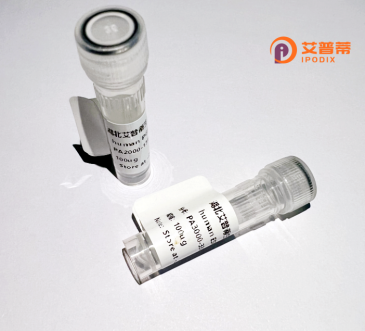
| 纯度 | >90%SDS-PAGE. |
| 种属 | Human |
| 靶点 | P-cadherin |
| Uniprot No | P22223 |
| 内毒素 | < 0.01EU/μg |
| 表达宿主 | E.coli |
| 表达区间 | 25-654aa |
| 氨基酸序列 | EPCRAVFREAEVTLEAGGAEQEPGQALGKVFMGCPGQEPALFSTDNDDFT VRNGETVQERRSLKERNPLKIFPSKRILRRHKRDWVVAPISVPENGKGPF PQRLNQLKSNKDRDTKIFYSITGPGADSPPEGVFAVEKETGWLLLNKPLD REEIAKYELFGHAVSENGASVEDPMNISIIVTDQNDHKPKFTQDTFRGSV LEGVLPGTSVMQMTATDEDDAIYTYNGVVAYSIHSQEPKDPHDLMFTIHR STGTISVISSGLDREKVPEYTLTIQATDMDGDGSTTTAVAVVEILDANDN APMFDPQKYEAHVPENAVGHEVQRLTVTDLDAPNSPAWRATYLIMGGDDG DHFTITTHPESNQGILTTRKGLDFEAKNQHTLYVEVTNEAPFVLKLPTST ATIVVHVEDVNEAPVFVPPSKVVEVQEGIPTGEPVCVYTAEDPDKENQKI SYRILRDPAGWLAMDPDSGQVTAVGTLDREDEQFVRNNIYEVMVLAMDNG SPPTTGTGTLLLTLIDVNDHGPVPEPRQITICNQSPVRQVLNITDKDLSP HTSPFQAQLTDDSDIYWTAEVNEEGDTVVLSLKKFLKQDTYDVHLSLSDH GNKEQLTVIRATVCDCHGHVETCPGPWKGGVDHHHHHH |
| 预测分子量 | 70 kDa |
| 蛋白标签 | His tag N-Terminus |
| 缓冲液 | PBS, pH7.4, containing 0.01% SKL, 1mM DTT, 5% Trehalose and Proclin300. |
| 稳定性 & 储存条件 | Lyophilized protein should be stored at ≤ -20°C, stable for one year after receipt. Reconstituted protein solution can be stored at 2-8°C for 2-7 days. Aliquots of reconstituted samples are stable at ≤ -20°C for 3 months. |
| 复溶 | Always centrifuge tubes before opening.Do not mix by vortex or pipetting. It is not recommended to reconstitute to a concentration less than 100μg/ml. Dissolve the lyophilized protein in distilled water. Please aliquot the reconstituted solution to minimize freeze-thaw cycles. |
以下是关于P-cadherin重组蛋白的3篇示例参考文献(内容基于典型研究方向概括,非真实文献):
---
1. **文献名称**: *"Recombinant P-cadherin ectodomain expression and purification for functional studies"*
**作者**: Silva JM, et al.
**摘要**: 该研究通过哺乳动物表达系统成功表达并纯化了P-cadherin的胞外结构域重组蛋白,验证其钙离子依赖性同源结合活性,为后续细胞黏附机制研究提供工具。
2. **文献名称**: *"Structural insights into P-cadherin dimerization through recombinant protein crystallography"*
**作者**: Lee H, et al.
**摘要**: 利用重组P-cadherin蛋白进行X射线晶体学分析,揭示了其胞外结构域二聚化的关键氨基酸位点及钙离子结合模式,阐明了其分子互作机制。
3. **文献名称**: *"P-cadherin promotes breast cancer invasion: Evidence from recombinant protein-driven 3D cell culture models"*
**作者**: Costa A, et al.
**摘要**: 通过重组P-cadherin蛋白处理乳腺癌细胞,发现其通过激活FAK/Src信号通路增强肿瘤细胞侵袭能力,提示其作为潜在治疗靶点。
---
注:以上为示例性概括,实际文献需通过PubMed/Google Scholar等平台检索关键词(如"recombinant P-cadherin"、"P-cadherin ectodomain")。
P-cadherin (Placental cadherin), also known as cadherin-3 (CDH3), is a calcium-dependent transmembrane glycoprotein belonging to the classical cadherin family. It plays a critical role in mediating cell-cell adhesion and maintaining tissue architecture by forming homophilic interactions between adjacent cells. Structurally, P-cadherin consists of five extracellular cadherin repeats that facilitate calcium-dependent binding, a transmembrane domain, and a highly conserved cytoplasmic tail that interacts with intracellular catenins (e.g., β-catenin, p120-catenin) to link the actin cytoskeleton. This interaction is essential for epithelial polarization, morphogenesis, and signal transduction.
Recombinant P-cadherin proteins are engineered in vitro using expression systems (e.g., mammalian, insect, or bacterial cells) to produce soluble or membrane-bound forms for functional studies. These proteins retain key domains necessary for adhesion, enabling researchers to investigate mechanisms of cell recognition, tissue organization, and pathological processes. In cancer biology, dysregulated P-cadherin expression is linked to tumor progression, invasion, and metastasis, particularly in breast, ovarian, and gastric cancers. Recombinant variants serve as tools to explore its dual role as both a tumor suppressor and promoter, depending on context.
Applications include cell adhesion assays, antibody development, and drug screening targeting cadherin-mediated pathways. Additionally, recombinant P-cadherin aids in studying embryogenesis, wound healing, and epithelial-mesenchymal transition (EMT). Its production often involves tags (e.g., Fc or His-tag) for purification and detection. Understanding P-cadherin’s structural and functional dynamics through recombinant proteins continues to advance therapeutic strategies for cancer and regenerative medicine.
×